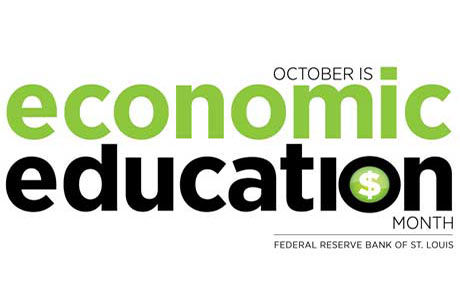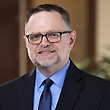Why Economic Education Month Matters
October is National Economic Education Month, a perfect opportunity for us to talk about the value of economic literacy. In the St. Louis Fed’s 2016 Annual Report, President James Bullard said, “Everyone needs to have an understanding of how the economy works to compete in today’s world.” But we as a society have underinvested in economic education, along with financial literacy, he added.

At its core, economics is about the business of everyday life—the decisions all of us make when spending, saving and investing while faced with limited resources. Everyone is faced with limited resources at a personal level. The businesses we run or for whom we work and the administrations that govern us are also faced with limited resources. Making informed choices and recognizing that there are costs and both positive and negative consequences to our choices are key elements of economic literacy.
Economics provides people with the tools they need to make informed economic decisions. When we make informed economic decisions, we benefit, and often society as a whole benefits.
Making Informed Economic Decisions
Let’s take a closer look at some of these decisions:
- Students who choose to attend a trade school or get a two-year or four-year degree acknowledge that they give up the goods, services and savings they could have had with the money they spend for school. They also give up the opportunity to earn income while attending classes and studying. However, they likely recognize the future consequences of this choice—better access to employment and higher income over their lifetimes than would be available with only a high school diploma. This is why we frequently discuss the pursuit of post-secondary education as an “investment in human capital.” Society benefits because these students are prepared for jobs, earn higher incomes and are more productive, which contributes to a growing economy. On the individual level, workers with more knowledge and skills often earn higher incomes. They are able to spend and save more over their lifetimes than those who don’t pursue post-secondary education.
- Likewise, business owners make decisions on a daily basis. The automaker weighs the pros and cons of building a new plant versus retrofitting an old one. A retailer must decide if a brick-and-mortar store can be profitable in an online world. A baker wonders if she should focus on bread for the masses or personalized cupcakes for the few. The choices these business owners make result in the production of goods and services that people value and affect the number of workers they employ—and good decisions can benefit society as a whole.
- Local governments are often asked by developers for tax breaks as a condition for building housing or retail shops and other businesses. The governments must decide if the potential for more tax revenue later offsets the foregone goods and services (roads, schools, etc.) that could be provided with that funding now. The best decision will provide the most benefits to the community relative to the costs.
Making the Grade in Economics Classrooms
When it comes to economic literacy, few of us can say we make the grade. Perhaps that’s because the teaching of economics isn’t a priority in most schools.
The 2020 Council for Economic Education (CEE) Survey of the States (PDF) found that only half of states require high school students to take an economics course. Students may have an opportunity to take an economics course in college, but in 2020 only 63% of U.S. high school graduates chose to attend college. And only 3% of U.S. colleges and universities require students to take an introductory economics course, according to a 2019-20 report from the American Council of Trustees and Alumni (PDF). As a result, many people don’t understand the basic economics needed today.
Among many who think more needs to be done in the schools are Rodney Gerdes and Vicki Fuhrhop, both members of one of the St. Louis Fed’s educator advisory boards who were quoted in the 2016 annual report.
Gerdes, a social studies teacher and department chair of Oakville High School in St. Louis, said: “Economic education is a central piece of civic education; educated informed citizens need to have a better grasp of the issues, which always have an economic base to them.”
Fuhrhop, a business teacher at Collinsville High School in Collinsville, Ill., points out: “We’re educating the consumers of the future, the citizens who will be out there voting and having an impact on our nation and the economy; they need to be prepared.”
The Federal Reserve Bank of St. Louis works to improve economic literacy with its partners across the Federal Reserve System. The St. Louis Fed offers a variety of free online classroom resources.
- Our public website at www.stlouisfed.org/education provides resources for use in pre-K through college classrooms.
- Our teacher portal at www.econlowdown.org enables teachers, Scout leaders, community group leaders, and home-schooling families to register, create classrooms, add students to those classrooms, and assign videos, audio casts and online modules for students to complete. In 2021, more than 115,000 students were enrolled through the portal, and on average, each student used six resources in the portal.
Making Learning Easy for Educators
In addition to providing high-quality resources, the Federal Reserve Bank of St. Louis offers free professional development programs for educators. These programs focus on building key content knowledge and demonstrating effective classroom pedagogy. Focusing on the “what” (content) and focusing on the “how” (pedagogy) are equally important. Research abounds that shows the positive relationship in economic education between teacher content knowledge and student achievement.
For example, one group of researchers found that students whose teachers participate in economic education professional development programs and use high-quality materials perform better on tests of economic knowledge. And because economics is an expansive discipline, with many core concepts, the more professional development that teachers have, the better prepared they are for classroom success. The St. Louis Fed also provides online professional development for educators—a key opportunity considering the times we live in.
Throughout Economic Education Month in October, encourage the administrators and teachers in your school or school district to teach economic decision-making and the basics of economics. You can point them to our St. Louis Fed websites for resources and encourage them to reach out to us for professional development. They can start early and build student understanding from pre-K through grade 12. Let’s make sure our students graduate from high school with an understanding of the economic system in which they live and the tools they need to make informed decisions as citizens, employees and employers.
References
College Enrollment & Student Demographic Statistics, published in August 2021 by EducationData.org.
“New President Bullard Bullish on Economics,” published in Summer 2008 in Central Banker.
“Fewer U.S. High School Students Opt for College,” by Floyd Norris, published April 24, 2014, in The New York Times.
This blog explains everyday economics and the Fed, while also spotlighting St. Louis Fed people and programs. Views expressed are not necessarily those of the St. Louis Fed or Federal Reserve System.
Email Us




